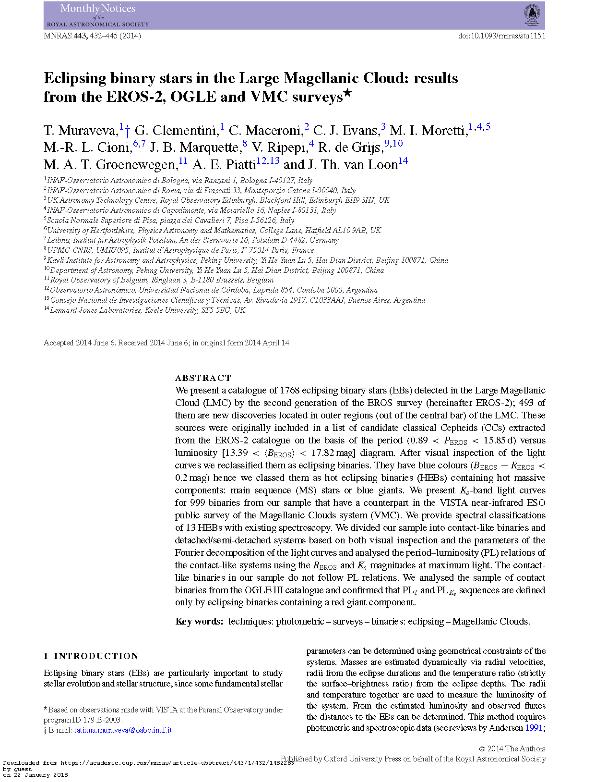Artículo
Eclipsing binary stars in the Large Magellanic Cloud: resultsfrom the EROS-2, OGLE and VMC surveys
Muraveva, T.; Clementini, G.; Maceroni, C.; Evans, C.J.; Moretti, M. I.; Cioni, M .R. L.; Marquette, J. B.; Ripepi, V.; de Grijs, R.; Groenewegen, M.A.T.; Piatti, Andres Eduardo ; van Loon, J. Th.
; van Loon, J. Th.
 ; van Loon, J. Th.
; van Loon, J. Th.
Fecha de publicación:
06/2014
Editorial:
Wiley Blackwell Publishing, Inc
Revista:
Monthly Notices of the Royal Astronomical Society
ISSN:
0035-8711
Idioma:
Inglés
Tipo de recurso:
Artículo publicado
Clasificación temática:
Resumen
We present a catalogue of 1768 eclipsing binary stars (EBs) detected in the Large Magellanic Cloud (LMC) by the second generation of the EROS survey (hereinafter EROS-2); 493 of them are new discoveries located in outer regions (out of the central bar) of the LMC. These sources were originally included in a list of candidate classical Cepheids (CCs) extracted from the EROS-2 catalogue on the basis of the period (0.89 < PEROS < 15.85 d) versus luminosity [13.39 < 〈BEROS〉 < 17.82 mag] diagram. After visual inspection of the light curves we reclassified them as eclipsing binaries. They have blue colours (BEROS − REROS < 0.2 mag) hence we classed them as hot eclipsing binaries (HEBs) containing hot massive components: main sequence (MS) stars or blue giants. We present Ks-band light curves for 999 binaries from our sample that have a counterpart in the VISTA near-infrared ESO public survey of the Magellanic Clouds system (VMC). We provide spectral classifications of 13 HEBs with existing spectroscopy. We divided our sample into contact-like binaries and detached/semi-detached systems based on both visual inspection and the parameters of the Fourier decomposition of the light curves and analysed the period–luminosity (PL) relations of the contact-like systems using the REROS and Ks magnitudes at maximum light. The contact-like binaries in our sample do not follow PL relations. We analysed the sample of contact binaries from the OGLE III catalogue and confirmed that PLI and PLKs PLKs sequences are defined only by eclipsing binaries containing a red giant component.
Palabras clave:
Techniques: Photometric
,
Surveys
,
Binaries: Eclipsing
,
Magellanic Clouds
Archivos asociados
Licencia
Identificadores
Colecciones
Articulos(CCT - CORDOBA)
Articulos de CTRO.CIENTIFICO TECNOL.CONICET - CORDOBA
Articulos de CTRO.CIENTIFICO TECNOL.CONICET - CORDOBA
Citación
Muraveva, T.; Clementini, G.; Maceroni, C.; Evans, C.J.; Moretti, M. I.; et al.; Eclipsing binary stars in the Large Magellanic Cloud: resultsfrom the EROS-2, OGLE and VMC surveys; Wiley Blackwell Publishing, Inc; Monthly Notices of the Royal Astronomical Society; 443; 1; 6-2014; 432-445
Compartir
Altmétricas



